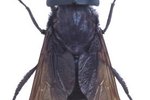
Shopping for fresh fruits and vegetables in the summer runs the risk of inviting unwanted guests into your home. A few days after your purchase, you may find tiny bugs congregating around the trash can or your garbage disposal, and these flying annoyances can spread rapidly. Dealing with fruit flies requires a mix of careful prevention as well as using the right techniques to wipe out the pests.
Fruit Flies
The most common fruit fly is drosophilia melanogaster, although several other species exist and all exhibit the same behaviors and life cycle. Fruit flies are attracted to unrefrigerated fruits and vegetables as well as sour or fermented liquids, and they have a lifespan of around 30 days. Fruit flies mature in about a week, depending on the ambient temperature, and a single fruit fly can lay around 500 eggs during its short life. This means an infestation can become severe if you don't take steps to stop it.
Source
Fresh produce is the most likely source of a fruit fly infestation. Any fruit or vegetable that at least partially ripens on the vine can attract fruit flies, but they tend to favor high-sugar plants such as bananas or tomatoes over less sweet produce. Eggs laid on produce in the field may lie dormant during refrigerated shipping, only to hatch once they spend time in your warm kitchen or cupboard.
Control
The key to dealing with a fruit fly infestation is to consider what the flies want and need to survive. First, you should cover or dispose of any fruits or vegetables they might find appetizing, especially any produce that is ripe or overripe. You should also drain your sink when not in use and place a stopper in your garbage disposal to prevent them from using leftover moisture to survive. Even the sour water in a sponge or mop may be enough to sustain a fruit fly infestation and encourage breeding.
Traps
Once you have removed food and water sources from the equation, you can lay traps to reduce the population of fruit flies. One simple fruit fly trap involves filling a cup or bowl with apple cider vinegar and adding a few drops of dishwashing liquid. The soap breaks the surface tension of the vinegar, so when the flies try to drink from the pungent liquid, they fall into it and drown. You can also create a paper funnel and place it on top of a glass or other vessel containing vinegar or a piece of ripe fruit as bait. The flies can crawl down the funnel, but once inside the vessel, they cannot fly back out.
References
Resources
Photo Credits
-
Ryan McVay/Photodisc/Getty Images
Writer Bio
Milton Kazmeyer has worked in the insurance, financial and manufacturing fields and also served as a federal contractor. He began his writing career in 2007 and now works full-time as a writer and transcriptionist. His primary fields of expertise include computers, astronomy, alternative energy sources and the environment.



